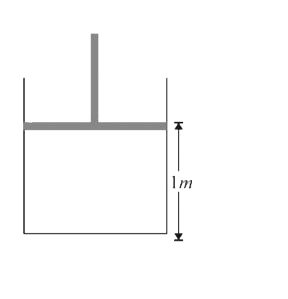Piston cylinder device initially contains 0.5m3 of nitrogen gas at 400kPa and 27∘C. An electric heater within the device is turned on and is allowed to apss a current of 2A for 5min from a 120V source. Nitrogen expands at constant pressure and a heat loss of 2800J occurs during the process.
R=25/3kJ/kmol−K
Electric work done on the nitrogen gas is
72kJ
36kJ
118kJ
9kJ
The correct Answer is:A
To solve the problem of calculating the electric work done on the nitrogen gas in the piston-cylinder device, we will follow these steps:
Step 1: Calculate the Power
The power (P) supplied by the electric heater can be calculated using the formula:
P=V×I
Where:
- V=120V (voltage)
- I=2A (current)
Substituting the values:
P=120V×2A=240W
Step 2: Convert Time to Seconds
The time (t) for which the current flows is given as 5 minutes. We need to convert this into seconds:
t=5minutes×60seconds/minute=300seconds
Step 3: Calculate the Total Work Done
The work done (W) can be calculated using the formula:
W=P×t
Substituting the values:
W=240W×300s=72000J
Since 1kJ=1000J:
W=72kJ
Step 4: Determine the Sign of Work Done
In thermodynamics, work done on the system is considered negative. Therefore, the work done on the nitrogen gas is:
W=−72kJ
Final Answer
The electric work done on the nitrogen gas is:
−72kJ
---
The power (P) supplied by the electric heater can be calculated using the formula:
P=V×I
Where:
- V=120V (voltage)
- I=2A (current)
P=120V×2A=240W
The time (t) for which the current flows is given as 5 minutes. We need to convert this into seconds:
t=5minutes×60seconds/minute=300seconds
The work done (W) can be calculated using the formula:
W=P×t
Substituting the values:
W=240W×300s=72000J
Since 1kJ=1000J:
W=72kJ
In thermodynamics, work done on the system is considered negative. Therefore, the work done on the nitrogen gas is:
W=−72kJ
The electric work done on the nitrogen gas is:
−72kJ
Topper's Solved these Questions
- KINETIC THEORY OF GASES AND FIRST LAW OF THERMODYNAMICSBOOK - CENGAGE PHYSICS ENGLISHCHAPTER - KINETIC THEORY OF GASES AND FIRST LAW OF THERMODYNAMICSEXERCISE - Interger
11 Videos
- KINETIC THEORY OF GASES AND FIRST LAW OF THERMODYNAMICSBOOK - CENGAGE PHYSICS ENGLISHCHAPTER - KINETIC THEORY OF GASES AND FIRST LAW OF THERMODYNAMICSEXERCISE - Assertion-Reasoning
6 Videos
- KINETIC THEORY OF GASESBOOK - CENGAGE PHYSICS ENGLISHCHAPTER - KINETIC THEORY OF GASESEXERCISE - Compression
2 Videos
- LINEAR AND ANGULAR SIMPLE HARMONIC MOTIONBOOK - CENGAGE PHYSICS ENGLISHCHAPTER - LINEAR AND ANGULAR SIMPLE HARMONIC MOTIONEXERCISE - Single correct anwer type
14 Videos
Similar Questions
Piston cylinder device initially contains 0.5m3 of nitrogen gas at 400kPa and 27∘C. An electric heater within the device is turned on and is allowed to apss a current of 2A for 5min from a 120V source. Nitrogen expands at constant pressure and a heat loss of 2800J occurs during the process.
R=25/3kJ/kmol−K
Number of moles of nitrogen gas is
View SolutionA gas expands from 2m3 to 2.5m3 at constant pressure 103 pa, the work done is
View SolutionA 2.5L flask contains 0.25mol each of sulphur dioxide and nitrogen gas at 27∘C. Calculate the partial pressure exerted by each gas and also the total pressure.
View SolutionThe volume of a gas expands by 0.25m3 at a constant pressure of 103Nm2. The work done is equal to
View SolutionA diatomic gas done 80J work when expanded isobarically. Find the heat given to the gas during this process?
View SolutionA gas filled in a cylinder fitted with movable piston is allowed to expand. What is the nature of the work done by the gas?
View SolutionTwo moles of an ideal gas are allowed to expand from a volume of 10dm3 to 2 m3 at 300 K against a pressure of 101.325 kPa. Calcualte the work done.
View SolutionAt 27∘C two moles of an ideal monatomic gas occupy a volume V. The gas expands adiabatically to a volume 2V. Calculate
(a) final temperature of the gas
(b) change in its internal energy and
(c) the work done by the gas during the process. [ R=8.31J/mol−K]
View SolutionThe piston cylinder arrangement shown contains a diatomic gas at temperature 300 K The cross sectinal area of the cylinder is 1m2. Initially the height of the piston above th base of the cyclinder is 1 m. The temperature is now raised to 400 K at constant pressure. There is no heat loss in the process..

Find the new height (in m) of the piston above the base of the cylinder.
View SolutionCalculate the amount of heat that must be supplied to 40 gm of nitrogen to raise its temperature by 45∘C at constant pressure if it is at room temperature. R=8.3Jmol−1K−1.
View Solution
